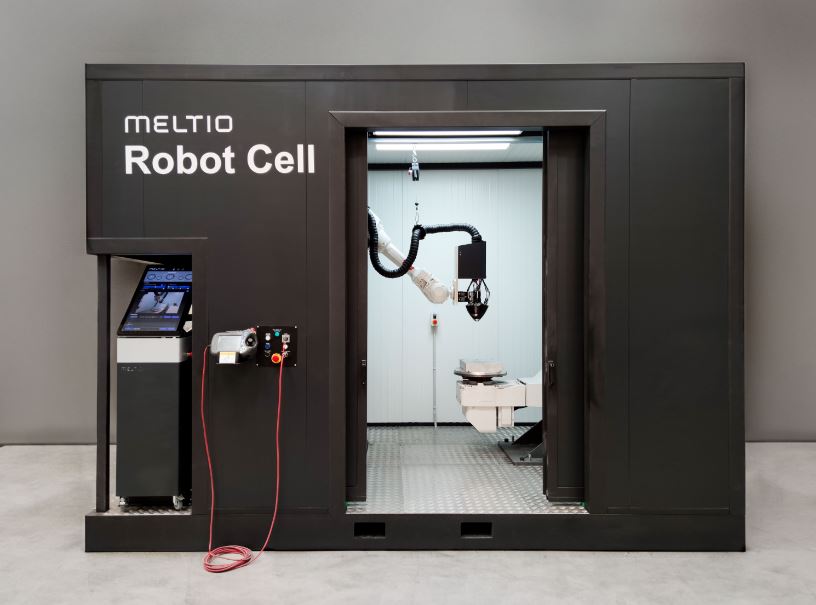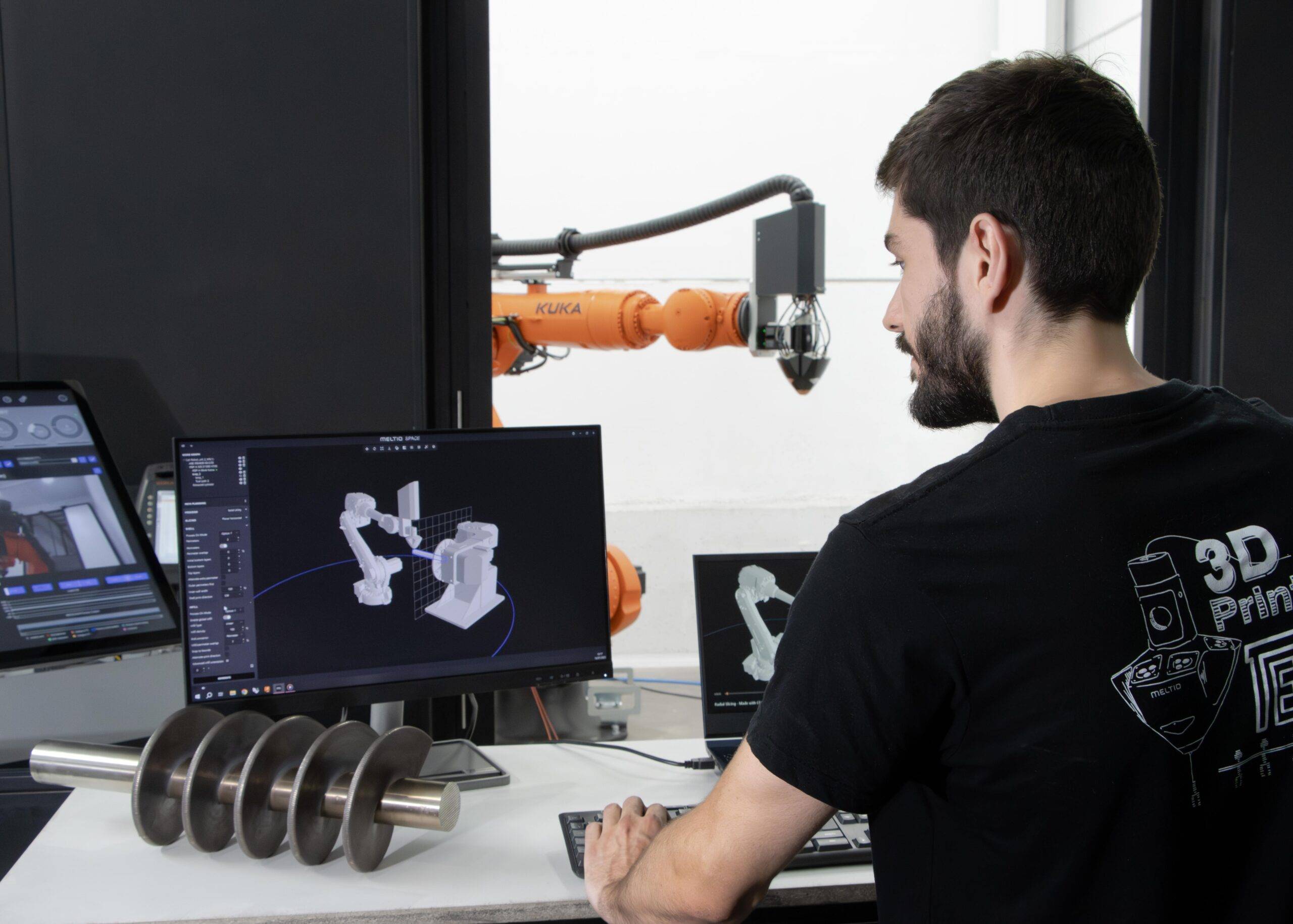Meltio unveiled two innovations to boost its metal 3D printing systems to answer all industrial applications linked to the use of an industrial robotic arm. Meltio is a manufacturer and developer of its unique wire-laser metal 3D printing technology for different industries. A technology created and patented in its unique Spanish factory in Linares (Jaén). With these two innovations, the Meltio Space software, and the new Meltio Robot Cell, the company is responding to the increasing use of metal 3D printing in different industrial sectors by offering the best tools for its adoption focused on ease of use and affordability.
In recent months, there has been a worldwide growing demand from industries that incorporate the Meltio head on a robotic arm –Meltio Engine Robot Integration– to print and repair metal parts with wire-laser additive manufacturing technology. The most commonly used metals are stainless steels, titanium, nickel alloys like Inconel, and tool steels, among others.
To meet the rising demand for the industrial sector, Meltio has launched the Meltio Space toolpath generator software to facilitate the use of its metal 3D printing solutions. By offering a user-friendly interface and comprehensive features, this robot slicer simplifies the integration of Meltio’s wire-laser metal 3D printing technology by offering a built-in robot library and postprocessors for some of the most popular robotic brands, including ABB, Kuka, FANUC, and Yaskawa.
This toolpath generator software for the Meltio Engine Robot Integration as well as for the turn-key solution Meltio Robot Cell, offers an easy-to-use interface for planar, nonplanar, and variable extrusion toolpaths. It also includes 2-axis workpiece positioner interpolation, kinematics simulation, collisions check, and cell configuration.
This slicer offers a new perspective on 3D printing by breaking free from the limitations of traditional 3-axis systems and expands the possibilities by incorporating advanced robotic manipulation capabilities. Featuring an intuitive design, users can quickly adapt to and leverage the benefits of robotic additive manufacturing (AM) without requiring expertise in robotics or programming.
Also, Meltio Space goes beyond the constraints of traditional 3-axis systems. With its integration of a 6-axis robotic manipulator and 2-axis workpiece positioners, it opens up a new realm of possibilities for metal 3D printing. The comprehensive coordination, multi-axis toolpath generation, and enhanced design freedom provided by the software empower users to create intricate, customized, and highly detailed metal parts.
Meltio Space includes presets with recommended material profiles and 3D printing parameters. With a strong focus on user experience, it offers a fully tailored customer journey centered around the seamless integration between the Meltio Engine and Meltio Space. The software provides custom-developed Meltio print profiles included in the Meltio materials portfolio. With its intuitive design, users can quickly adapt to and leverage the benefits of robotic AM without requiring expertise in robotics or programming.
The Meltio Space robot slicer employs a virtual model of the real robot movement. This advanced feature enables users to simulate the kinematics of the robot, ensuring accurate and precise printing. Additionally, the slicer performs collision checks with the part being printed, minimizing the risk of errors or damage during the additive manufacturing process.
Meltio Robot Cell
The second recent innovation created by Meltio is the turn-key Meltio Robot Cell to boost the performance of a robotic arm converted into a system to 3D print metal parts in a safer, more reliable, and highly accurate way by controlling the entire process offering also the most competitive lead time, between 4 and 6 weeks.

In its vision as a patented Directed Energy Deposition (DED) 3D printing technology developer and manufacturer to accompany and be the reliable solution for industries around the world to adopt Meltio’s wire-laser metal 3D printing solutions that reduce costs and improve manufacturing processes, the Spanish multinational presented a new hardware innovation: the Meltio Robot Cell. This new system includes a standard ABB robotic arm inside the cell and allows standard metal 3D printing starting from a build plate in a factory as well as for adding features or repairs on existing parts.
The volume and work area defined in the Meltio Robot Cell workspace meet all manufacturing needs using our industrial-level additive manufacturing technology to take full advantage of Meltio’s metal 3D printhead and be able to manufacture parts in an industrial environment autonomously thanks to its monitoring and safety features. The robot and positioner are installed on a self-supporting platform, as well as a laser-safe enclosure together with the Meltio Engine, Meltio Space, and accessories.
With the Meltio Robot Cell, Meltio company is fulfilling most of the applications that industry and integrators need when printing industrial metal parts.
The Meltio Robot Cell is designed as a plug-and-play system, with a single electrical power supply and a single inert gas supply. The environmental conditions are standard and this cell cannot be outdoors or unprotected from the sun and dust, it must be in a controlled environment. This solution allows the customer to receive a product ready to use for robotic metal 3D printing.
The Meltio Robot Cell is certified and tested to operate with an ABB robotic arm as standard configuration and aimed at all industries. It is most certainly an evolution of the Meltio Engine Robot Integration as a base production model to enable industries to incorporate 3D printed parts manufacturing with the Meltio head integrated into a robot into their production systems.
As Meltio Engine Product Manager, Alejandro Nieto is excited about this new innovation:
“Meltio’s main commitment with the launch of the Meltio Robot Cell is to offer all types of industries the ability to manage the entire manufacturing process using our metal 3D printing technology consisting of a Meltio head integrated into a robotic arm and in a safe environment, in order to just produce parts. This new hardware system allows the customer to receive a ready-to-use cell for robotic metal 3D printing, removing the integration process and long assembly lead times. The Meltio Robot Cell has a specific area for every supply the cell requires on a daily basis, only connecting to the inert gas and electric supply is enough to start manufacturing.
The Meltio Robot Cell also provides the industrial customer with a working protocol. Relative to existing offerings in the market today, the Meltio Robot Cell is very competitively priced and its price is below 300,000 dollars ex-works. The cost of the solution is also competitive when compared with thermoplastic and concrete 3D printing systems as seen in other sectors that demand 3D printing for structural parts. This cell has the possibility to be delivered with other robot brands on the market to be more responsive to customers in terms of availability and technical capability. The Meltio Robot Cell is compatible with the open hardware platform that allows Meltio to integrate our metal 3D printing head on any brand of robotic arms”.
For more information, please contact: [email protected]
https://meltio3d.com/applications/
Subscribe to AM Chronicle Newsletter to stay connected: https://bit.ly/3fBZ1mP
Follow us on LinkedIn: https://bit.ly/3IjhrFq
Visit for more interesting content on additive manufacturing: https://amchronicle.com


